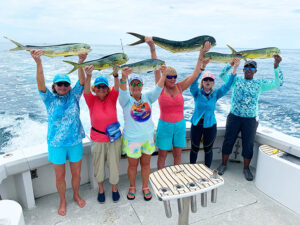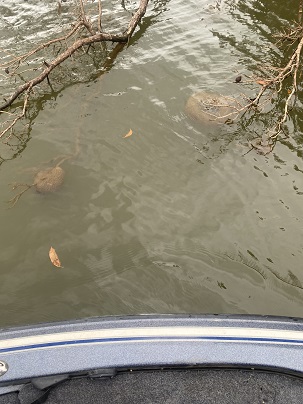The fishing industry contributed 49.8 billion dollars to the US economy in 2018 (most recent report available). That spending contributed $63.5 billion to the National GDP and total economic impact, including all multiplier effects was nearly $126 billion in 2018 according to this report https://asafishing.org/wp-content/uploads/2019/02/Sportfishing-in-America-Revised-November-2018.pdf
Female anglers spend billions of dollars each year, creating tens of billions in economic impacts.

Female fishing participation on rise
Florida data for fishing:
Florida ranks number one for numbers of anglers. One out of every four trips in the U.S. occurs in Florida and 60 percent of recreational fish caught in the U.S. are caught in Florida.
The highest region for female participation is the South Atlantic. Its share has the strongest three-year annual growth rate overall.
Female Participation over Time
While female fishing participation fell slightly in 2021 from its 2020 all-time high, in 2021 there were 2.8 million more female anglers than five years prior, and 3.8 million more than in 2011.
Female activities outside of fishing
In addition to fishing, nearly half of all female participants walked to stay fit. The next most popular activities were camping, hiking, bowling and bicycling.
This information is provided by Ladies, Let’s Go Fishing (LLGF), according to statistics from RBFF, NMFS and other sources. The goal of LLGF is to activate, recruit and retain new anglers through educational programming and communications, aligning with the mission of the American Sport Fishing Association’s R3 endeavor.
Featured on national network television and more, the series is supported by major partners including Recreational Fishing and Boating Foundation, Take Me Fishing, Vamos a Pescar, Mercury, Magic Tilt trailers, Shearwater Boats, Power-Pole, Penn, TACO Metals, Lowrance, Fish and Wildlife Foundation of Florida and Fish Florida. Largest Annual Sponsors are Freedom Boat Club, ICOM America, CCA Florida STAR, Bob’s Machine Shop, AFTCO, Costa, Smith Optics, Frogg Toggs, Hubbards Marina, Star Brite and Future Angler Foundation. Other sponsors and donors are listed on the website.
For the 2022 Special Report on Fishing from RBFF visit takemefishing.org.
Fishing Industry statistics from 2021 or most recent available according to the Special Report on Fishing:
54.4 million Americans ages 6 and over went fishing
Women now account for 37 percent of anglers in the U.S.
3.7 million were first-time participants, of that number, 43 percent were women
Nearly 41 million Americans ages 6 and over freshwater fished
13.8 million fished in saltwater
19.4 million female anglers fished
2.8 million more female anglers than five years prior, and 3.8 million more than in 2011.
1.6 million female participants were first-timers
7.9 million children ages 6 to 12 fished
5 million adolescents ages 13 to 17 fished
4.7 million Hispanics ages 6 and over fished
17 percent of the American population went fishing
More Americans fish then play golf and tennis combined in 2016, no new data available
Income brackets, females participating in fishing:
25% Income of over $100,000
24% income 25K to $50K
19% $50K to 75K
Fishing and the economy:
Fishing contributed 49.8 billion dollars to the US economy in 2018 (most recent report available). That spending contributed $63.5 billion to the National GDP and total economic impact, including all multiplier effects was nearly $126 billion in 2018 according to this report https://asafishing.org/wp-content/uploads/2019/02/Sportfishing-in-America-Revised-November-2018.pdf
Female anglers spend billions of dollars each year, creating tens of billions in economic impact dollars.
Story and images provided by Ladies, Let’s Go Fishing
About Ladies, Let’s Go Fishing
The Ladies, Let’s Go Fishing Foundation (LLGF) is a national charitable 501C3 organization dedicated to attracting women and families to fishing and encouraging conservation and responsible angling. LLGF promotes networking among women anglers and emphasizes mentorships. Founded in 1997 by Betty Bauman, of Ft. Lauderdale, Florida, LLGF has over 9,000 graduates and is the largest organization in the world whose objective is to introduce women and families to fishing. In addition to fishing education and hands-on practice, most events offer a fishing experience depending on venue, from charter boats to land-based fishing. The mission is supported by sponsors and donors. Both Bauman and the University series – dubbed “The No-Yelling School of Fishing” – are known nationally in the fishing and marine industries. The organization has earned rave reviews from media including Inside Edition, The Early Show, NBC Nightly News, CBS, Good Morning America, Outdoor Life Network, USA Today, the Wall Street Journal, Southern Living and more.
ABOUT Future Angler Foundation
The Future Angler Foundation (FAF) is an incorporated 501(c)(3) non-profit foundation formed in April of 2012. The FAF’s mission is to “Create New Anglers and Boaters” through its support of angler education and boating safety programs hosted by passionate, knowledgeable volunteers throughout the U.S. and through its “Getting Families Fishing” initiative, a series of free source digital educational programs developed to engage young anglers and boaters as they educate them about angling in an exciting, informative, and effective manner. More information about the FAF can be found online at www.futureangler.org.








